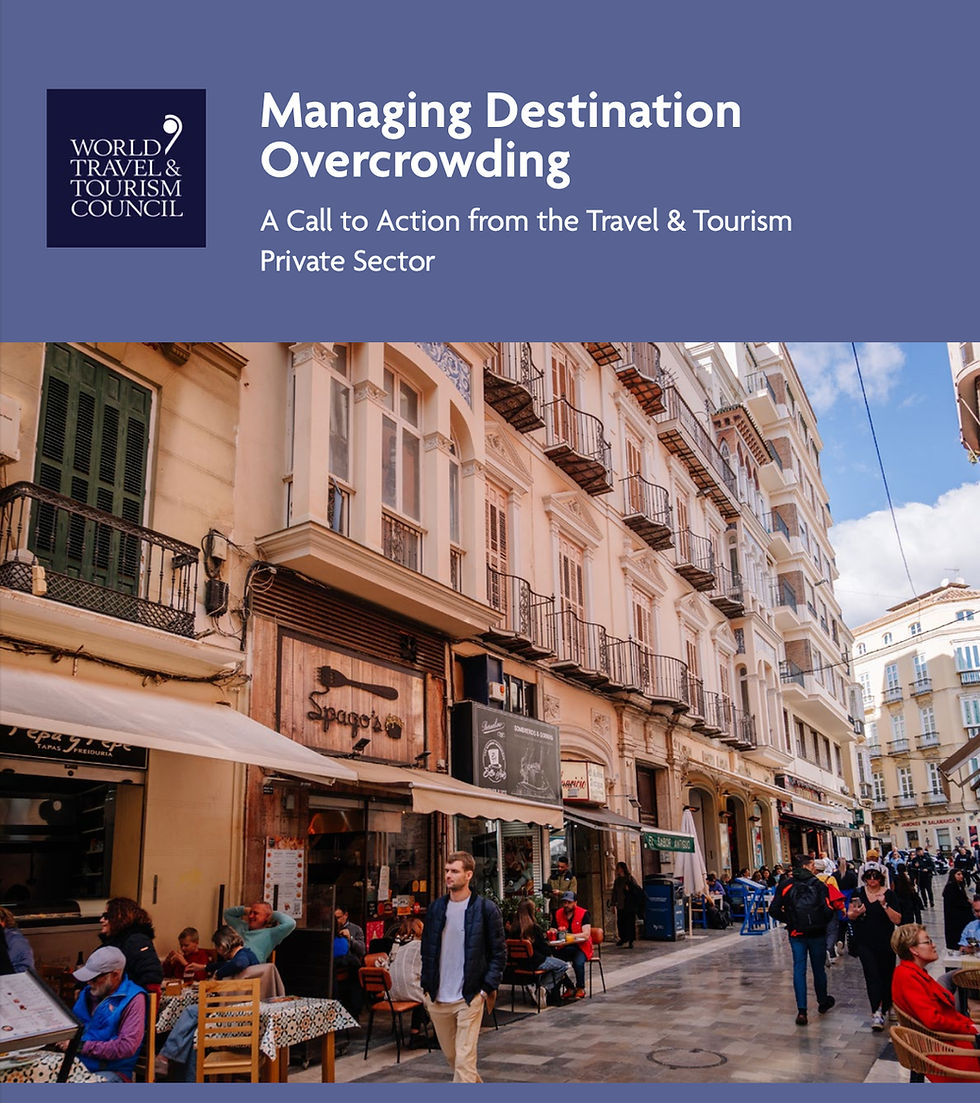Managing Overtourism: A Deep Dive into the WTTC Report
- Vanessa Mariscal

- Sep 18
- 3 min read

Tourism is undeniably one of the most powerful economic sectors in the world. It generates jobs, fuels local growth, fosters cultural exchange, and—when managed responsibly—can become a driver of sustainable development.
Yet, in recent years, it has become clear that tourism also carries risks. Poorly managed, it can strain communities, deepen inequalities, and degrade the very destinations that attract travelers in the first place.
The World Travel & Tourism Council (WTTC), which represents the global private travel and tourism sector, addresses this challenge in its report “Managing Destination Overcrowding.” The document provides a structured, evidence-based, and people-centered roadmap for tackling overtourism.
The Context: Growth Without Planning
Tourism has expanded rapidly, often without adequate planning. Iconic cities such as Venice, Barcelona, Dubrovnik, and Amsterdam have gone from global success stories to case studies of overcrowding, social tensions, and environmental stress.
The WTTC urges destinations to move from reactive responses to proactive, integrated strategies that rethink the relationship between tourism, communities, and territory.
Six Pillars for Managing Overtourism
1. Organize Effectively
Fragmented governance is one of the biggest obstacles. The report calls for integrated governance platforms involving public and private sectors, local communities, and environmental groups. These must have stable resources, legitimacy, and real decision-making power. Examples such as VisitFlanders and the Barcelona model demonstrate that with political will and a long-term vision, collaborative governance is achievable.
2. Plan with Purpose
Destinations cannot leave their future to market forces alone. WTTC emphasizes strategic planning co-created with residents, aligning tourism with urban, social, and environmental agendas. Examples like Copenhagen’s “The End of Tourism As We Know It” or Athens’ visitor experience redesign show how planning can transform the relationship between visitors and locals.
3. Base Decisions on Evidence
“You can’t manage what you don’t measure.” Too often, decisions are based on perception or media pressure. The report urges destinations to gather relevant data and indicators: visitor flows, resident sentiment, fragile zones, and resource pressures. Cities like Benidorm (water management) and Dubrovnik (cruise monitoring) are already applying data-driven solutions with positive results.
4. Stay Vigilant
Collecting data is not enough; it must be monitored continuously. WTTC calls for real-time monitoring, early-warning systems, and digital platforms. Importantly, residents’ voices should be included as a key indicator.
5. Invest Wisely
Overtourism is not just about raising new taxes. Tourism already generates significant fiscal revenue; the challenge is ensuring reinvestment where it’s most needed.WTTC highlights the 4Rs of financial management: Reinvent, Reserve, Responsibility, and Report. Success stories from the Balearic Islands and Iceland demonstrate that transparent reinvestment enhances both community well-being and perceptions of tourism.
6. Empower Communities
Tourism has no future if it doesn’t benefit those who live in the destinations. Empowerment must be psychological (pride of place), economic (fair opportunities), and political (meaningful participation). Examples like Revelstoke, VisitScotland, and Intrepid Travel illustrate how shared ownership transforms tourism into a positive force.
Final Reflection
Tourism growth should not be measured only in arrival numbers, but in quality of life, equity, and sustainability. The WTTC’s six-pillar framework is not a quick fix, but it provides a pragmatic roadmap for cities, regions, and countries that want to take the future of tourism seriously.
Overtourism is a pressing challenge, but it is also an opportunity to build a fairer, more resilient, and more sustainable model—one where tourism strengthens, rather than undermines, the communities and places we love.


Comments